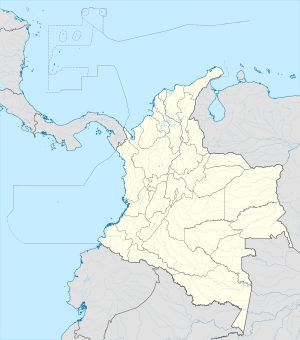Codazzi
| Agustín Codazzi | |||
|---|---|---|---|
| Municipality and town | |||
|
|||
 Location of the municipality and town of Agustin Codazzi in the Department of Cesar. |
|||
| Location in Colombia | |||
| Coordinates: 10°02′12″N 73°14′13″W / 10.03667°N 73.23694°WCoordinates: 10°02′12″N 73°14′13″W / 10.03667°N 73.23694°W | |||
| Country |
|
||
| Region | Caribbean | ||
| Department | Cesar | ||
| Founded | 1700 | ||
| Founded by | Salvador Félix Arias | ||
| Government | |||
| • Mayor | Luis 'Luchito' Vladimir Peñaloza Fuetes (2016-2019) |
||
| Area | |||
| • Municipality and town | 1,739 km2 (671 sq mi) | ||
| • Urban | 5.49 km2 (2.12 sq mi) | ||
| Elevation | 131 m (430 ft) | ||
| Population (2015) | |||
| • Municipality and town | 50,829 | ||
| • Density | 29/km2 (76/sq mi) | ||
| • Urban | 38,727 | ||
| Website | www |
||
Agustín Codazzi, or Codazzi, is a city and municipality of the Department of Cesar in Colombia. It was founded in 1784 by the Spanish Captain Salvador Felix de Arias with the name of El Pueblito del Espiritu Santo but later renamed after the Italian cartographer, Giovanni Battista Agostino Codazzi, who died in this place in 1859. It is located along the Serranía del Perijá, covering some of the area pertaining to the valley of the Cesar River.
In 1958 Codazzi was proclaimed a municipality due to its rapid population increase in the 1950s and 1960s, triggered by an agricultural boom of cotton, that attracted people searching for jobs from many departments of Colombia; mainly from Tolima, Huila, Santander, North Santander, Antioquia, Cundinamarca, Bolivar and Magdalena.
When this boom ended, the agroindustry opted for other products like palm, sugar cane, liquors and milk products. In 2005 the municipality of Codazzi had approximately 52,219 inhabitants.
The coat of arms of the city is divided into four parts: the upper left shows an allegory of the religious festivals of the divine shepherdess; in the top right are the mountains of Perija; the bottom part shows the fruits and products of agriculture such as coffee, corn and cotton flowing from the horns, like the bows and arrows that make memories to the Yukpa tribe, ancient inhabitants of their territory.
...
Wikipedia



